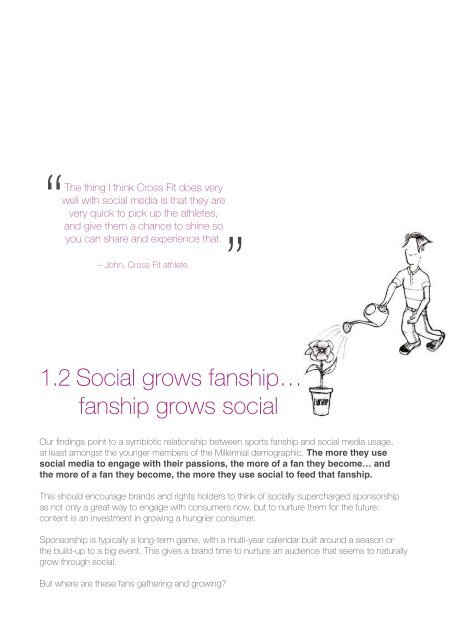99SYN14528_SocialSportsFanDoc-V2
99SYN14528_SocialSportsFanDoc-V2
99SYN14528_SocialSportsFanDoc-V2
Create successful ePaper yourself
Turn your PDF publications into a flip-book with our unique Google optimized e-Paper software.
The younger the sports fan, the greater the effect<br />
social media has on their fanship<br />
22-25yrs<br />
17%<br />
18-21yrs<br />
34%<br />
“The thing I think Cross Fit does very<br />
well with social media is that they are<br />
very quick to pick up the athletes,<br />
and give them a chance to shine so<br />
you can share and experience that.<br />
– John, Cross Fit athlete.<br />
“<br />
16-17<br />
18-21<br />
22-25<br />
16-17yrs<br />
49%<br />
1.2 Social grows fanship…<br />
fanship grows social<br />
Our findings point to a symbiotic relationship between sports fanship and social media usage,<br />
at least amongst the younger members of the Millennial demographic. The more they use<br />
social media to engage with their passions, the more of a fan they become… and<br />
the more of a fan they become, the more they use social to feed that fanship.<br />
This should encourage brands and rights holders to think of socially supercharged sponsorship<br />
as not only a great way to engage with consumers now, but to nurture them for the future:<br />
content is an investment in growing a hungrier consumer.<br />
Sponsorship is typically a long-term game, with a multi-year calendar built around a season or<br />
the build-up to a big event. This gives a brand time to nurture an audience that seems to naturally<br />
grow through social.<br />
But where are these fans gathering and growing?<br />
In order to understand the effect of social media on<br />
fanship, we asked participants whether they were a<br />
bigger fan of the sports/teams/athletes they liked<br />
because of social media. 49% of 16-17 year-olds<br />
agreed that they were, compared to 40% of 18-21<br />
year-olds and only 28% of those in the 22-25 bracket.<br />
This suggests that the younger the fan, the more social<br />
media affects their level of fanship. This poses interesting<br />
questions: is this age skew because those 18-21 yearolds<br />
are too young to have ever really been consciously<br />
interested in sports like rugby, football or tennis without<br />
the facilitation of social media?<br />
Face-to-face interviews with sports fans offered up<br />
another possibility. Cross Fit fan-athletes spoke of the<br />
‘sense of community’ that they feel in their online sports<br />
circles, and added that social media plays a key role<br />
in enabling them to endorse what is a relatively new<br />
sport, to which they want to attract more participants<br />
and fans. They noted that whilst fans of traditional sports<br />
(like rugby) may use social media as ‘one of many’<br />
platforms for discussion, fans of less traditional sports<br />
(like Cross Fit) don’t have this luxury, and champion<br />
social media as a main source of information and tips.<br />
Content provided by teams or individuals has therefore<br />
been pivotal to establishing fanship around these<br />
‘non-traditional’ sports.<br />
49% of 16-17 yearolds<br />
agree that<br />
they are a bigger<br />
sports fan because<br />
of social media<br />
compared to 28%<br />
of 22-25 year olds


